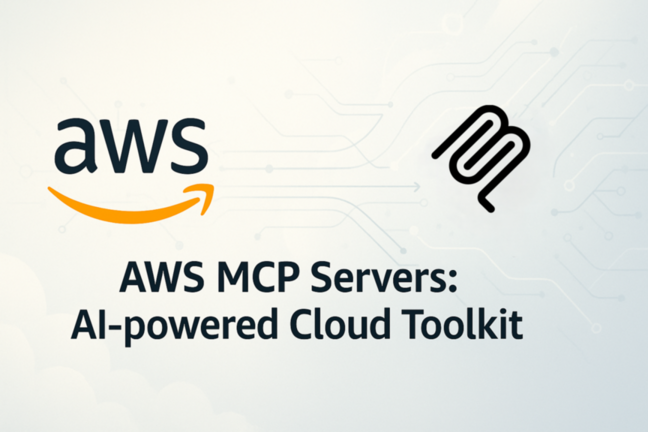Introduction
The rise of AI copilots and agent-based systems has changed how developers interact with cloud infrastructure. Instead of navigating complex consoles and APIs, teams now expect natural language interactions and intelligent automation. At the center of this transformation is the Model Context Protocol (MCP) — a standard that bridges AI agents with external tools, APIs, and servers.
The big news? AWS has officially adopted MCP, releasing a wide family of AWS MCP Servers. This move makes it easier for developers, cloud architects, and DevOps teams to connect AWS services directly into AI-powered workflows. From deploying cloud infrastructure to optimizing costs, MCP servers bring AI copilots for AWS to life — giving teams new ways to automate and accelerate operations.
What is MCP?
The Model Context Protocol (MCP) is an open standard designed to let AI models and tools communicate securely and efficiently. Instead of relying on custom plugins or integrations, MCP provides a unified interface for connecting AI assistants with external data sources, APIs, and services.
Originally pioneered by Anthropic for Claude, MCP has now been embraced by AWS to power AI-driven cloud automation. With MCP servers, developers can:
| Benefit | Description |
|---|---|
| Standardization | A single protocol for AI–tool communication, reducing fragmentation. |
| Security | Consistent, access-controlled server connections instead of ad-hoc scripts. |
| Flexibility | Connect AI agents to diverse AWS services with minimal setup. |
| Extensibility | Build custom MCP servers to expand beyond the official AWS set. |
By adopting MCP, AWS ensures that AI copilots are not just conversational but operational — capable of provisioning, monitoring, and automating cloud resources directly.
AWS MCP Server Categories
AWS has released dozens of MCP servers covering the full spectrum of cloud operations. Below is an organized view of the categories:
| Category | MCP Servers | Highlights / Use Cases |
|---|---|---|
| Infrastructure & Deployment | Cloud Control API, Terraform, IAM, Architecture Diagram Generator | Manage AWS resources, IaC workflows, access control, auto-generate architecture diagrams |
| AI & ML | Amazon Bedrock Knowledge Bases, Semantic Search, Model Deployment & Tuning | Retrieval-augmented generation (RAG), enterprise search, ML pipeline setup |
| Data & Analytics | Amazon RDS, Redshift, OpenSearch, Kinesis/Data Streams | Database queries, data warehousing, log/analytics search, real-time streaming |
| Cost & Operations | AWS Pricing API, Cost Explorer, CloudWatch Metrics, FinOps MCPs | Cost optimization, anomaly detection, monitoring, and budget tracking |
| Specialized Domains | Healthcare APIs, Serverless (Lambda, Step Functions), Container Management (ECS, EKS) | Compliance-ready healthcare workloads, serverless orchestration, container operations |
This table highlights how MCP servers act as connectors, allowing AI copilots to “speak AWS” fluently — and more importantly, take action.
How to Use AWS MCP Servers
Setting up AWS MCP servers is straightforward, and most integrations are designed for local development environments. Here’s how you can get started:
| Tool / Platform | How It Works | Setup Guide |
|---|---|---|
| Amazon Q in IDEs (VS Code, JetBrains, Eclipse) | Integrates AWS copilots directly into your coding workflow. | AWS Docs – Q in IDE Setup |
| Amazon Q CLI | Command-line access to MCP servers for automation and DevOps workflows. | Guide: Q CLI Installation |
| Cursor IDE | A modern IDE with deep MCP support for project-level management. | Cursor Docs – MCP Setup |
| Claude Desktop | Add AWS MCP servers into your Claude AI assistant. | See Anthropic’s official docs. |
| Terminal Tools (uv, uvx) | Run MCP servers directly via terminal for scripting and automation. | MCP Installation Reference |
👉 For the latest full list of AWS MCP servers, check the official AWS MCP GitHub repo.
Why This Matters
The introduction of AWS MCP servers goes beyond convenience — it’s a paradigm shift. With MCP, your AI copilots can:
| Benefit | Impact |
|---|---|
| Provision resources | Spin up EC2 instances, databases, or infrastructure from natural language prompts. |
| Monitor systems | Fetch CloudWatch metrics, check logs, or alert on anomalies. |
| Optimize costs | Analyze spending via Cost Explorer or Pricing APIs. |
| Enable AI-driven DevOps | Automate deployments, rollbacks, and scaling with intelligent context. |
This opens doors to self-healing infrastructure, smart assistants for FinOps, and AI-driven DevOps pipelines. It’s not just about talking to AWS — it’s about operating AWS with AI.
Conclusion & Call-to-Action
The AWS family of MCP servers represents a major leap toward AI-powered cloud automation. For developers, architects, and DevOps engineers, it means faster workflows, richer copilots, and more intelligent infrastructure management.
If you’re building the next generation of AI copilots for AWS, MCP servers are your starting point.
👉 Explore the official AWS MCP GitHub repository to see the complete list and start experimenting today.
